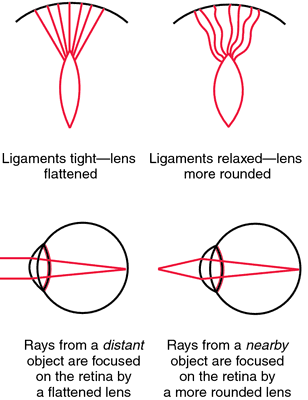The nurse is testing a client's visual accommodation. Which of the following should the nurse recognize as an assessment finding from visual accommodation?
The pupils constrict when the examiner's index finger slowly moves toward the client's nose.
The client involuntary blinks in the presence of bright light directed over the pupils during the eye exam.
The client's peripheral vision becomes sharper when the examiner shines a light over the pupils.
The pupils dilate when the examiner's index finger slowly moves toward the client's nose.
The Correct Answer is A
A. The pupils constrict when the examiner's index finger slowly moves toward the client's nose.
This statement is correct. Visual accommodation is the process by which the eye's lens changes shape to focus on objects at varying distances. When an object moves closer to the eyes, the pupils constrict to adjust and focus on the near object, preventing double vision.
B. The client involuntarily blinks in the presence of bright light directed over the pupils during the eye exam.
This statement describes the pupillary light reflex, not visual accommodation. The pupillary light reflex is the response of the pupils to light exposure.
C. The client's peripheral vision becomes sharper when the examiner shines a light over the pupils.
This statement is not accurate. Peripheral vision sharpness is not related to visual accommodation. Visual accommodation mainly involves adjusting focus for objects at varying distances.
D. The pupils dilate when the examiner's index finger slowly moves toward the client's nose.
This statement is incorrect. Pupils should constrict, not dilate, when focusing on a near object (as in visual accommodation). Dilation occurs in low-light conditions or in response to sympathetic stimulation.

Nursing Test Bank
Naxlex Comprehensive Predictor Exams
Related Questions
Correct Answer is D
Explanation
A. Perform the confrontation test:
The confrontation test is a basic visual field screening test. It assesses the peripheral vision by having the patient cover one eye and the examiner covers the opposite eye. The patient and the examiner then bring their fingers into the visual field from the periphery, and the patient indicates when they see the fingers.
B. Ask the patient to read the print on a handheld Jaeger card:
Jaeger cards are used for near vision testing. The patient reads progressively smaller print to assess their near vision acuity.
C. Determine the patient's ability to read newsprint at a distance of 12 to 14 inches:
This method assesses near vision. It is often used informally in clinical settings, where the patient is asked to read a newspaper or similar print at a comfortable reading distance.
D. Use the Snellen chart positioned 20 feet away from the patient:
The Snellen chart is a standardized chart used for visual acuity testing. It is placed 20 feet away from the patient, and the patient is asked to read the letters or symbols on the chart with one eye covered at a time.
Correct Answer is B
Explanation
A. Simultaneously palpating both arteries to compare amplitude: While comparing amplitudes is important, using the diaphragm of the stethoscope to listen for bruits (abnormal whooshing sounds indicating turbulent blood flow) is a more specific and accurate method for assessing the carotid arteries for potential vascular issues.
B. Listening with the diaphragm of the stethoscope to assess for bruits: This technique allows the nurse to detect abnormal sounds (bruits) that could indicate partial blockages or stenosis in the carotid arteries, suggesting a risk of stroke or transient ischemic attack.
C. Instructing the patient to take slow deep breaths during auscultation: Deep breaths are more relevant during lung auscultation. Carotid artery assessment focuses on detecting abnormal sounds and assessing blood flow rather than respiratory patterns.
D. Palpating the artery at the base of the neck: Palpation alone does not provide enough information about potential blockages or abnormalities in the carotid arteries. Listening with a stethoscope allows for a more detailed assessment of blood flow and the presence of bruits.f the nurse hears a bruit during auscultation, they shouldnotpalpate the carotid artery. A bruit suggests partial obstruction (carotid stenosis), and compressing the artery further could worsen blood flow.
Whether you are a student looking to ace your exams or a practicing nurse seeking to enhance your expertise , our nursing education contents will empower you with the confidence and competence to make a difference in the lives of patients and become a respected leader in the healthcare field.
Visit Naxlex, invest in your future and unlock endless possibilities with our unparalleled nursing education contents today
Report Wrong Answer on the Current Question
Do you disagree with the answer? If yes, what is your expected answer? Explain.
Kindly be descriptive with the issue you are facing.
